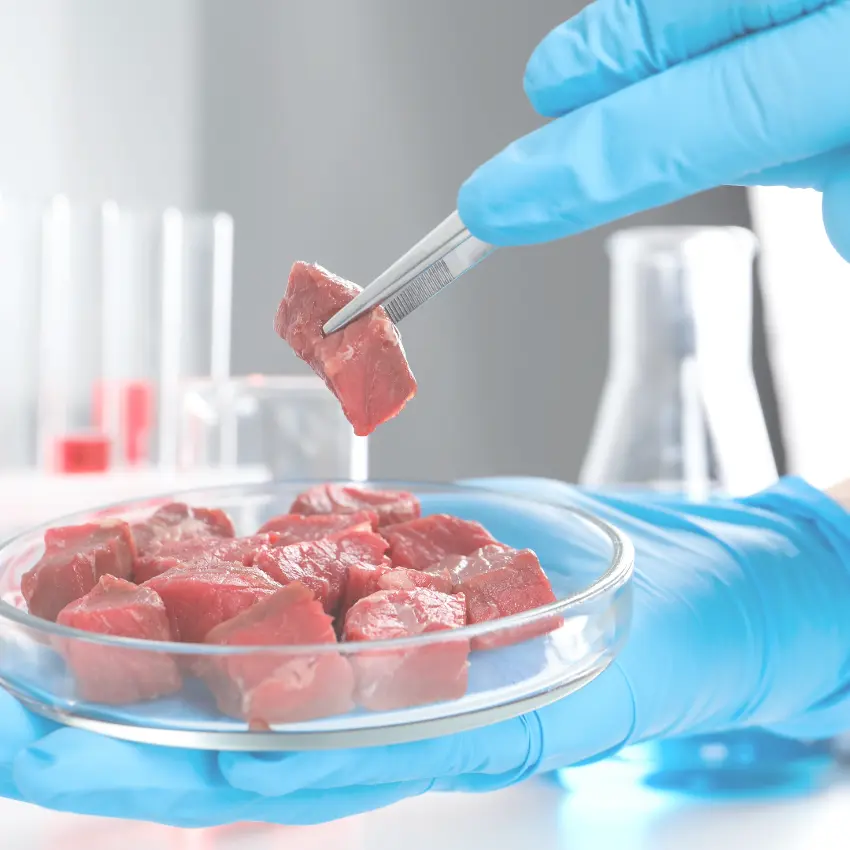High cell viability is crucial when harvesting cells for lab-grown meat because it can directly impact the success and quality of the cultivated meat production process. Beyond cell viability, as typically measured through trypan blue-based tests, cell health describes the overall biological condition and function of a cell, which may not correlate well with basic measures of viability(1). Maintaining both high viability and high cell health is important for several reasons:
- Proliferation in Bioreactors: In the bioreactor environment where cells are cultured, high cell viability and health is essential for sustained proliferation. As cells are collected and re-seeded into larger bioreactors, cell health must be maintained in order to achieve the expected growth rate and yield of cells available for harvesting.
- Efficient Tissue Formation: Healthy, non-stressed cells are more likely to contribute to the formation of desired tissues in a traditional bioreactor or when seeded onto scaffolding(2). They can proliferate and differentiate effectively, leading to the development of muscle tissue that closely resembles traditional meat.
- Quality of the Final Product: The post-mortem metabolic behavior of harvested cells can influence the properties of cultivated meat products, particularly those that are “unprocessed” – not minced or ground(3). Maintaining cell health throughout the harvesting step may assist in the optimization of the texture, color, and flavor in cultured meat products and achieve consistency in post-harvest processes beyond what is even possible with conventionally farmed meat by influencing(4).
- Economic Considerations: Cultivated meat production can be resource-intensive, and achieving high cell viability and health can contribute to a more efficient use of resources. It maximizes the yield of usable cells, reducing the need for additional rounds of cell culture and associated costs.
In summary, cell health, in addition to viability, is not just a technical detail—it's a key factor in producing lab-grown meat that not only meets but potentially exceeds the expectations for taste, texture, and overall quality. Tubular bowl centrifugation offers a distinct advantage in achieving high viability in cell separation steps. This advantage is attributable to the way cells are gently introduced into the centrifuge and the straightforward, low-surface-area geometries compared to alternative technologies.
Moreover, CARR Biosystems’ reusable (clean- and steam-able) and single-use tubular bowl separation platforms ViaFuge® and UniFuge® contribute to the scalability of the cultivated meat industry, provide manufacturers with the ability to seamlessly scale from benchtop process development to large-scale manufacturing. When incorporated into harvest, media exchange, and washing applications, these platforms help to make lab-grown meat a more viable and sustainable option to meet the growing demand for alternative protein sources.
If you are looking for a partner who brings expertise, innovation, and a focus on advancing the field of cultivated meat production, contact CARR Biosystems for a free consultation.
References
National Institute of Science and Technology. (2021, September 16). Cell Counting for Cell Therapies. NIST. https://www.nist.gov/programs-projects/cell-counting-cell-therapies
Biotechnology Progress. (2009, February 03). Can shear stress direct stem cell fate? AIChE. https://aiche.onlinelibrary.wiley.com/doi/10.1002/btpr.124
Frontiers in Nutrition. (2020, March 24). Sensorial and Nutritional Aspects of Cultured Meat in Comparison to Traditional Meat: Much to Be Inferred. NIH. https://www.ncbi.nlm.nih.gov/pmc/articles/PMC7105824/
Good Food Institute. (Retrieved 2023, November 28). Post-harvest processes and end-product characterization for cultivated meat. GFI. https://gfi.org/solutions/post-harvest-processes-and-end-product-characterization-for-cultivated-meat/




